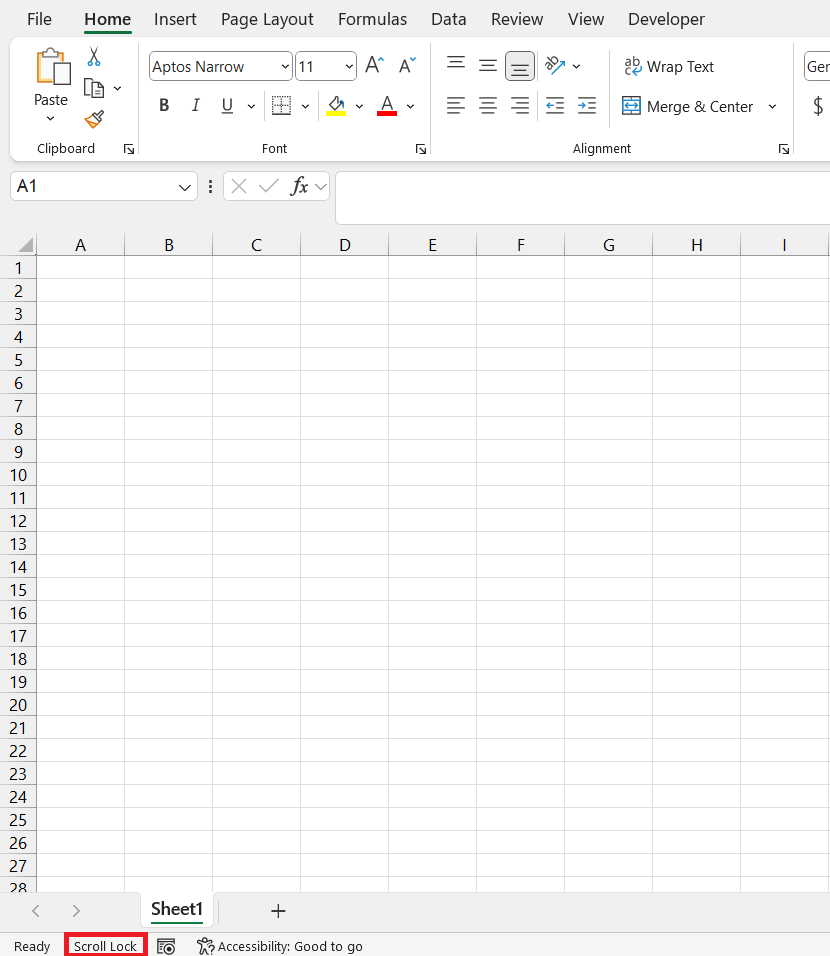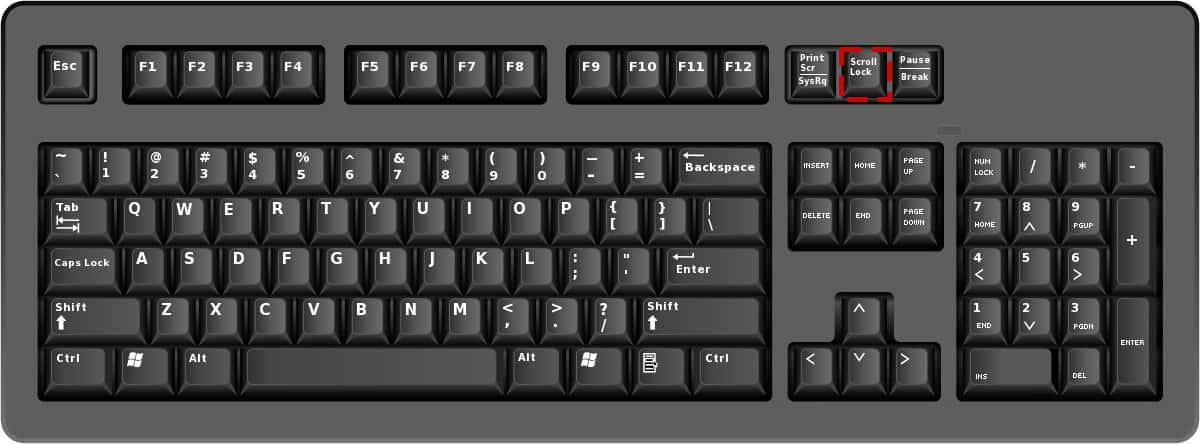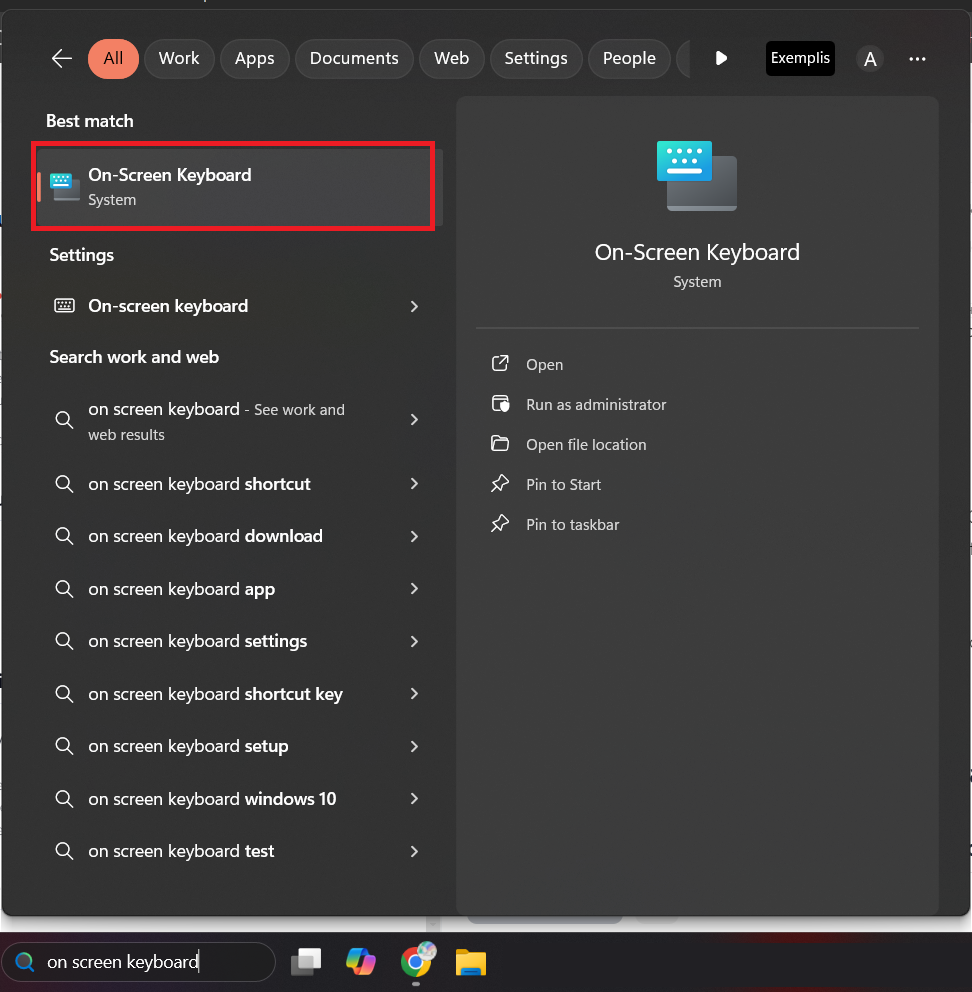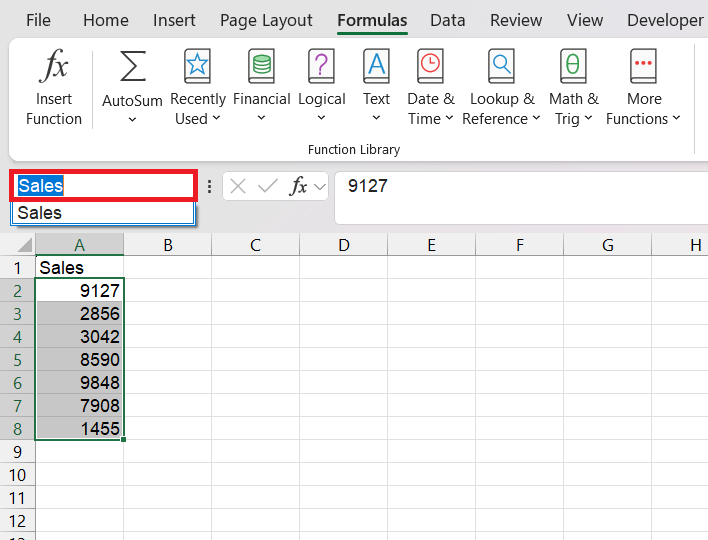Have you ever been working in Excel, trying to move from one cell to the next, but instead, the entire worksheet scrolls, leaving your selection stuck in place? If so, you’ve likely encountered Scroll Lock. Although it’s not a feature most people use often, Scroll Lock can cause confusion when it’s accidentally turned on. In this article, I’ll explain what Scroll Lock is, how it impacts Excel, and how I manage to turn it on or off whenever needed.
Key Takeaways:
- Scroll Lock changes how the arrow keys work in Excel, moving the worksheet instead of the cell selection.
- It is a legacy feature and can be turned on accidentally, causing confusion.
- Visual cues like the status bar or a light on the keyboard help identify if the Excel Scroll Lock is active.
- To turn off Scroll Lock, use keyboard shortcuts or the On-Screen Keyboard.
- Alternative Excel navigation tools, like Freeze Panes and keyboard shortcuts, offer more efficient data handling.
Table of Contents
Introduction to Excel Scroll Lock Feature
Discovering the Purpose of Scroll Lock in Excel
Scroll Lock is a legacy feature found on older keyboards. When it’s activated, it changes how the arrow keys work in Excel. Normally, pressing an arrow key moves the selection from one cell to another. But with Scroll Lock turned on, the arrow keys scroll the entire worksheet, while the selected cell stays in place.
The Scroll Lock feature in Excel is quite the enigma, often hiding in plain sight on our keyboards. Originally, it was intended to facilitate easy perusal of data – think of it as panning across a landscape using binoculars without altering your position.
In practical terms, it allows me to scroll through my spreadsheet without losing my place, which can be particularly handy when dealing with sizable amounts of data. Though its relevance may seem diminished in this era of mouse scrolls and touchpads, for spreadsheet aficionados, knowing about Scroll Lock can be a game-changer.
Common Situations When Scroll Lock Affects Excel Users
I often encounter users who are baffled by the sudden change in their Excel spreadsheet’s behavior, not realizing that Scroll Lock has been accidentally enabled. A classic scenario is when the arrow keys start scrolling the entire worksheet instead of moving from cell to cell.
Another typical situation arises when working on shared computers or terminals with different keyboard layouts, leading to inadvertent activation of Scroll Lock.
Moreover, due to the feature’s obscurity, it’s not uncommon for users to spend considerable time troubleshooting or questioning their Excel skills, not recognizing that a simple toggle of Scroll Lock can remedy their navigation woes.
Identifying If Scroll Lock is On or Off
Visual Indicators and Status Bar Messages
When Scroll Lock is engaged on my Excel, one of the first things that grab my attention is the status bar at the bottom of the window. It’s a subtle yet clear visual cue – a text indicator displaying “Scroll Lock” – that lets me know the feature is active.
Furthermore, the color of the Scroll Lock (ScrLk) key on some keyboards is also a visual clue—blue often means enabled, whereas black signifies disabled.
This handy little dashboard of visual prompts keeps me informed and in control of the navigation at all times.
The Impact of Scroll Lock on Arrow Key Functionality
When Scroll Lock is active in Excel, it throws a curveball at my navigation habits. Instead of moving the active cell highlight from one cell to another, the arrow keys shift the whole worksheet view in the direction of the arrow pressed.
This is especially disruptive when I expect the straightforward, cell-by-cell movement to edit or review my data. It’s a common source of irritation and can slow down work progress significantly if I’m not aware of it.
For example, if I’m meticulously working through a data entry task, pressing an arrow key with Scroll Lock enabled can streak away from the current viewpoint, sending me on a wild spreadsheet tour instead of to the neighboring cell.
Quick Solutions to Turn Off Scroll Lock
Using Keyboard Shortcuts for Various Computer Models
There is no direct keyboard shortcut for Scroll Lock in Excel on most keyboards, especially on modern laptops where the Scroll Lock key has been removed. Press Fn + C or Fn + K or Fn + S (depends on the laptop model).
Remembering or finding the right shortcut can often provide a quick and efficient resolution to inadvertently enabled Scroll Lock, allowing me to navigate Excel with my preferred level of precision and ease.
Utilizing the On-Screen Keyboard Method
When the physical keyboard falls short, the On-Screen Keyboard in Windows becomes my savior. It’s always there at my fingertips, virtually, even when a Scroll Lock key isn’t present on my actual keyboard. To summon it, I click on the Windows button, type “On-Screen Keyboard,” and select it from the search results.
Once it materializes onscreen, locating and clicking the ‘ScrLk’ button within will either engage or disengage Scroll Lock, depending on its current state.
This method offers a reliable fallback and ensures that no matter what kind of device or keyboard layout I am dealing with, I always have a way to control Scroll Lock in Excel.
Additional Tips for Smooth Excel Navigation
Enhancing Productivity by Mastering Excel Scroll Features
Mastering Excel’s scroll features can significantly enhance our productivity when working with large datasets. Using the scroll bar or mouse wheel, I can navigate swiftly through records.
When precision is key, I utilize the ‘Ctrl’ + arrow keys to jump to the edge of data regions, which saves substantial time.
By leveraging these Excel functionalities, I can navigate massive spreadsheets effectively, keeping the tedious scrolling to a minimum and focusing more on the analysis itself.
Alternatives to Scroll Lock for Easier Data Handling
Rather than wrestling with Scroll Lock, I opt for Excel’s robust repertoire of navigation tools to handle data with ease—tools like “Freeze Panes” enable me to lock rows or columns, which is incredibly handy for perusing through wide or lengthy spreadsheets without losing sight of header information.
Similarly, “Split Windows” comes to my rescue when I need to compare different sections of the same worksheet.
For keyboard enthusiasts, keyboard shortcuts that employ the ‘Ctrl’ and arrow keys whisk me to the edge of my data, making lightning-fast jumps between data points possible without scrolling through each intermediate cell.
And then there’s the “Name Box,” which I use to jump directly to a specific cell or range just by typing its address—a neat trick for those who know exactly where they need to go.
Each of these methods provides a different flavor of control and efficiency, allowing me to tailor my data handling in Excel to suit my specific task or preference.
FAQs on Scroll Lock in Excel
Q1: How do I unlock the Scroll Lock in Excel?
To unlock Scroll Lock in Excel, simply press the Scroll Lock key (often labeled as ‘ScLk’ or ‘ScrLk’) on your keyboard. If there’s no Scroll Lock key, use the On-Screen Keyboard by pressing the Windows logo key + ‘Ctrl’ + ‘O’ and click the ‘ScrLk’ button.
Q2: What is the shortcut key to toggle Scroll Lock in Excel?
The shortcut key to toggle Scroll Lock in Excel can vary, but it’s typically the ‘Fn’ key plus the ‘S’, ‘C’, or ‘ScrLk’ key on most laptops. On some keyboards, you may need to press ‘Fn’ + ‘Shift’ + ‘F14’.
Q3: How do I access the virtual keyboard to deactivate Scroll Lock?
To access the virtual keyboard on Windows, press ‘Windows+R’, type ‘osk’, and hit ‘Enter’. On the on-screen keyboard, click the ‘ScrLk’ key to deactivate Scroll Lock.
Q4: What are the signs that the Scroll Lock is activated or deactivated?
When Scroll Lock is activated, the arrow keys scroll through the worksheet instead of moving the cell selection. A light on your keyboard may illuminate, and “Scroll Lock” may be displayed on Excel’s status bar. If these signs are absent, then Scroll Lock is likely deactivated.
Q5: How do I manage Scroll Lock settings in Windows 10?
To manage Scroll Lock in Windows 10, you can toggle it using the On-Screen Keyboard. Access it by typing ‘On-Screen Keyboard’ in the Start menu, then click the ‘ScrLk’ key within the app to turn Scroll Lock on or off.
John Michaloudis is a former accountant and finance analyst at General Electric, a Microsoft MVP since 2020, an Amazon #1 bestselling author of 4 Microsoft Excel books and teacher of Microsoft Excel & Office over at his flagship MyExcelOnline Academy Online Course.














